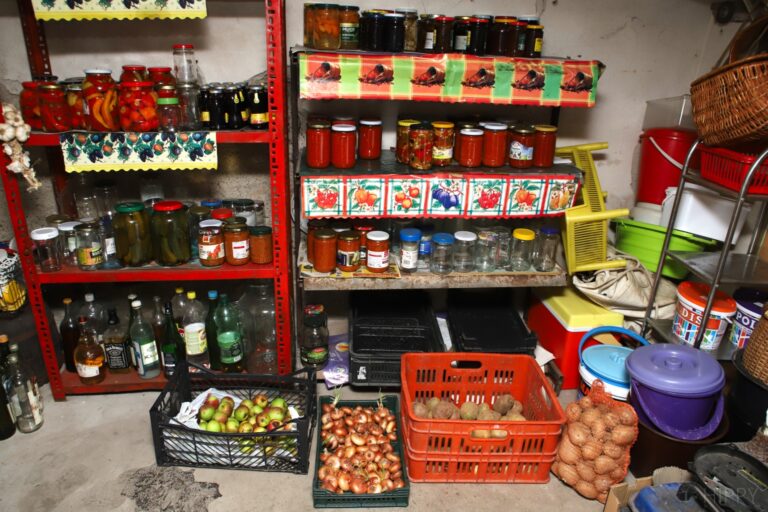A root cellar is an essential facility for anyone planning to grow enough food to feed their family through the winter season. Most root cellars are located below, or at least partially below ground.

A root cellar can be anything from a trash can buried in the soil to a purpose-built room. The concept of these storage areas is simple: at certain depths, temperatures and humidity remain constant despite the weather conditions above ground.
This begs the question: how deep does a root cellar need to be?
On average, a root cellar should be 10 feet (3 meters) deep. However, in certain locations where the soil is dry, or sandy, you may need to dig deeper, since that’s where the temperature is a stable 32º to 40ºF (0° to 4.5°C).
However, the depth of a root cellar will be different in a cold climate. Here it is necessary to be at least partially below the permafrost level, whilst in a warmer climate, it is necessary to reach the level where temperature levels are stable and can protect crops from the heat.
Consequently, the depth of a cellar in a cold climate will be different from a cellar in a warm climate.
The Position of the Cellar
Many things should be considered before attempting to construct a root cellar. Do not think It is just a question of grabbing a spade and digging a hole that is 10 feet deep. Taking various considerations into account could affect how deep the cellar needs to be.
When digging we are looking for the correct level that will naturally maintain an even temperature. Locating the frost line is essential since ensuring the cellar is at least partially below that line will enable it to function correctly.
Most root cellars are positioned by digging into a hill, or on the side of the house that is the coolest. For most this will be on the north side. Potentially, the cellar will not need to be as deep on the north side compared to the south.
In some northern states, it is best to position the cellar on the southern side of the property. In this location, we are using the sun to prevent the temperature in the root cellar from dropping too much, and may not need to be so deep.
The Type of Soil
The type of soil on a property has a great effect on how deep the cellar needs to be due to two natural properties:
- Heat capacity. This is the level of heat that can be added to or removed from the soil before it will change its temperature.
- Thermal conductivity. This is a level that measures how well a soil will permit a transfer of heat.
Looser sandier or loamy soils are less effective at retaining heat compared to firmer soils such as clay. Consequently, a root cellar in this type of soil will need to be deeper than in other soil types.
Wet soils are not affected by temperature fluctuations in the same way as dry soils. Consequently, saturated soil will maintain a stable temperature more efficiently than dry soil. A root cellar will not need to be as deep in this type of soil.
It is important to remember that soil types can be completely different in extremely close areas. Therefore, the depth that the cellar needs to be could be different at locations that are quite close.
Digging Near Water Sources
If you’ve ever gone fishing on a hot day and put your beers in the cold running water, you’re aware of the cooling effects of the water.
I have seen root cellars built near creeks and streams. Some have also incorporated the flow of water through the cellar itself.
Although this sounds perfect, for most people digging to any depth near running water can be very problematic, since the water level may prevent the correct depth from being achieved.
Is Digging Necessary?
We have seen that by digging around 10 feet into the ground, we can create a room that will keep our food fresh and edible for a long time. However, is there any way we can create such a facility without digging into the ground?
Using basements and existing outbuildings could remove the necessity to dig to any depth, as these can be easily adapted to create a root cellar.
Finding the Perfect Depth
Research is the key to establishing exactly how deep a root cellar needs to be in a particular location. Try digging a small test hole and burying a sensor to monitor the temperature and humidity.
Monitoring the readings over some time will establish if the depth is sufficient to create the correct conditions.
Monitoring the temperature is time well spent since a depth of 5 feet may be sufficient, it would be a shame to dig 10 feet down when it is not necessary.
Conclusion
A root cellar employs the time tested method of using the stable temperatures and humidity that can be found by creating a storage facility below ground. A root cellar is a natural refrigerator, and will allow food to be stored for as long as possible.
Existing basements or outbuildings can be adapted to make them fit for purpose, however, the best option for creating a root cellar is digging into the ground to create a purpose-built store.
How deep the root cellar should be depends on several factors, some of which may be beyond your control.
Location is one such factor, since different climate zones will provide different air and soil temperatures. Higher temperatures will require a deeper cellar.
The type of soil on the property will also affect how deep we need to dig. Different soil types have different properties of heat capacity and thermal conductivity. A root cellar in dry, sandy soil will need to be deeper than one in wet soil.
Although 10 feet (3 meters) is the recommended depth to create an efficient root cellar, in some areas you may not need to dig as deep.

Three years ago, I bought an off-grid Cortijo in a small valley in the Andalucian mountains. Although, perhaps the lifestyle is in my genes as my grandfather and his four brothers were Homesteaders in Alberta Canada in the 1900s.
The mountains of Spain are a difficult place to grow many of the flowers that I was used to in the UK. However, veggies grow well year-round. Peppers, tomatoes, potatoes, lettuce, cucumber, melons, and chard all fare well in the Mediterranean climate. Almond trees provide me with a cash crop of around 1 ton while still retaining some to make almond milk and flour.
Meet the rest of the Homesteading Hippy team here.
